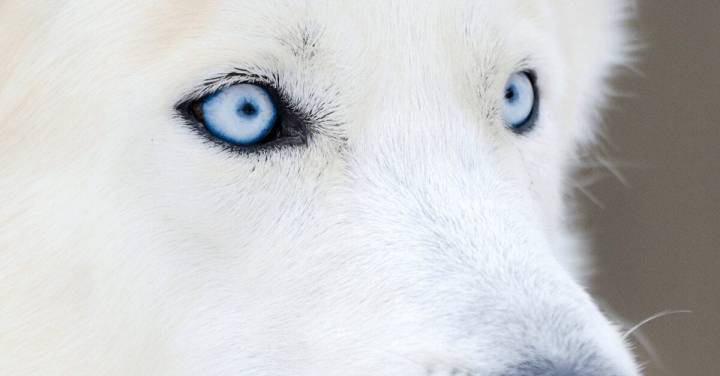As with many things in our world, dogs have many legends and myths surrounding them. We’re not just talking about mythical dogs, but myths or misunderstandings about dogs and different aspects their appearance, behavior, size and more.
Connect with a verified veterinarian in minutes. Licensed vets are available 24/7 to answer your questions. No need to worry about your furry family member.
In this article, we’ll take a look at several myths about dogs and give you the facts to help you better understand your precious canine companion. You could rename this article as “Dog Myths Debunked”
Myths About Dogs with Two Colored Eyes
Have you ever been the pet parent of a dog with two different colored eyes? Dogs with one blue eye and one brown eye can be startling when you see them for the first time. There are several myths surrounding dogs with two different colored eyes. It’s said they can see better at night with one eye and see better in the daytime with the other. Another myth from Native Americans says dogs with one blue eye and one brown eye can see heaven with one eye and Earth with the other.
Did you know this condition has a name? It’s called heterochromia iridium. Humans and other animals also bear this striking condition. This condition results in the lack of melanin (pigment) in one eye and can be either genetic or caused by injury or eye disease. If the condition happens later in life, it’s called acquired heterochromia.
This striking trait is most often seen in the following breeds of dogs:
- Australian Shepherds
- Alaskan Malamutes
- Dalmatians
- Huskies
- Border Collies
- Great Danes
- Catahoula Leopard Dogs
- Welsh Corgis
- Shetland Sheepdogs
- Beagles
- Dachshunds
- Chihuahuas
- Shih Tzus
In these breeds, this trait is congenital (genetic). Some people are afraid to become pet parents to these dogs for fear the eyes are an indication of other health problems. If the condition is genetic, your pup should be just fine. Some of the myths surrounding these dogs include the fear eyes indicate deafness, impaired vision, etc.
One thing you might need to be aware of is that heterochromia can cause light sensitivity in the light colored eye. This is because lighter colored eyes don’t contain as much pigment to block light from hitting the retina. As a result, it’s possible your pup could be sensitive to bright sunlight. You might consider getting him a pair of doggie shades or dog goggles to protect his eyes during the day in strong sunlight.
If your dog develops heterochromia later in life, this could be a sign of underlying disease or an eye injury. It can also be an indication of infection, inflammation, etc.
Be sure to have your fur baby checked by the vet if you’ve noticed a sudden change in his eye color
Myths About Dogs Howling
Why do dogs howl? Myths about for the cause of this classic canine behavior. You’ve heard that dogs (and other canines) howl at the full moon and you’ve probably heard that dogs howl when a loved one dies (such as a pet parent or family member). If you do a little research on the Internet, you’ll also read that dogs, in some cultures, are believed to have the ability to perceive spiritual beings (ghosts?) and are said to keep away evil spirits with howling.
So, why do dogs howl? Howling is a complex behavior and can be caused by many things. Researchers haven’t quite figure out exactly why dogs howl. However, howling is a very natural, normal behavior for dogs–there are a few reasons dogs howl:
1. Stress: dogs experiencing stress (like separation anxiety, etc.) may howl to release tension and attract attention. You may also notice other signs of stress, including depression, chewing/gnawing on anything in sight (furniture or shoes, for instance), pacing or potty problems.
2. Medical causes: a dog might also howl if he’s sick, in pain or been injured.
3. Communication: in the wild, wolves and coyotes howl as a means to communicate with their pack and to alert other animals to stay out of their territory.
If your dog is an occasional howler, then it’s just a normal behavior. It’s also normal if he howls at sirens or even if he howls to your favorite tunes. However, if he all of a sudden becomes a chronic howler, it may be a good idea to have the vet check him over. Your fur baby could have an underlying medical condition that needs attention.

Review symptoms, medications & behavior to keep your pets healthy with a Vet Online in just minutes.
Ask a Vet Live NowDog Training Myths
When it comes to dog training, misunderstandings abound about methods, dog behaviors and more. You’ve probably heard that it’s a good idea rub your dog’s nose in his pee if he’s gone on the floor as a form of punishment. Another myth about dog training says puppies that are dominant will be aggressive, while those that are submissive will be the most trainable. One more example of a misunderstanding of dog training is that a dog needs to know who the pack leader is—you. These just aren’t true.
The most effective form of dog training is positive reinforcement, rather than using methods that punish your dog for unwanted and unappreciated behaviors. Positive reinforcement methods use praise and reward for good behavior. The use of treats, too, can help reinforce your pup to repeat the behavior. Research has proven this method works best with all types of training, and is used by organizations that train assistance dogs, bomb disposal dogs and dogs used for search and rescue missions.
Positive reinforcement methods help you create a bond with your dog, rather than instilling fear of you by punishing him.
You and your fur baby will have a healthier, happier relationship if you use positive reinforcement methods to train him
Dominance Myths and Dog Training Realities
Another dog training myth says that your dog is showing dominance over you and others with certain behaviors. Some of these behaviors include:
- Your fur baby barking at you: there are many reasons your pup could be barking at you. Remember, barking is a form of communication in canines, so your fur baby’s just trying to tell you something. Your dog may be playing, letting you know he needs to go out to do his business, or maybe he’s letting you know it’s supper time. However, if your dog is barking excessively, there may be some underlying reasons. For example, he may be bored or scared, or maybe he’s learned this behavior because you’ve encouraged it in some way. Taking care of the underlying cause(s) may help to get your dog to stop excessive barking.
- Dogs jumping on people (to assert their dominance): most of the time, your fur baby just wants to get closer to your face to say hi! When dogs greet each other, they’ll often touch noses and kiss each other on the face/mouth. This is normal canine behavior. It’s also possible that you or another person have somehow reinforced this behavior in your dog. Inconsistent training could be the cause. If your dog is a greeting jumper, teach him to sit quietly when company comes, and then give him a reward for good behavior. Only give him attention when he’s not jumping. However, make sure to intervene if your dog is jumping on a child or someone who is frail or elderly. Their safety comes first.
These examples are simple, but are two of the most sited ways that dogs show their dominance over others. This just isn’t always the case. The cause can often be traced to poor or inconsistent training methods, or lack training and/or unintentional training (rewarding or giving attention to unwanted behaviors).
Common Small Dog Myths
Now, let’s take a look at some of the most common small dog myths! People often believe smaller dogs are cute and easy to train. There are also some negative beliefs about small dogs that are quite common. You’ve probably heard a few of these! If you’re the owner of a small dog, you may get a chuckle out of some of the misperceptions surrounding smaller dogs.
1. Small dogs are easier to take care of than large dogs: size is no indicator of whether or not a dog will be easier to care for. Small dogs are easier to transport—you can even carry them! However, small dogs can be quite boisterous and high maintenance. Small dogs can have big dog personalities, after all.
2. Small dogs are yappy: some small breeds can be louder and more talkative then bigger breeds. Think of Boston Terriers, Chihuahuas and Miniature Poodles. However, any dog can be “yappy” or bark excessively. Large dogs, small dogs and any dog breed can exhibit this unwanted behavior. It’s important to remember that sometimes we, as pet parents, are responsible for somehow encouraging these types of behaviors in our pets.
3. Small dogs don’t need as much exercise as bigger dogs: if you’re the pet parent of a small dog, you’ll know this isn’t necessarily the case. Rather, small dogs can be little “balls of fire,” filled to bursting with energy! Here, consider Jack Russell Terriers, Beagles, Yorkies and others. These dogs were all bred to hunt and are filled to the brim with energy and agility. In fact, many small breed dogs benefit from the same amount of exercise as you’d give a larger dog.
These are just a few of the most common small dog myths—now let’s take a look at some big dog myths!
Big Dog Myths
Myths abound about big dogs. This may be due to the fact that their size can be somewhat intimidating to people, especially those who are afraid of dogs. Here are three of the most common myths about big dogs:
1. Big dogs are more aggressive: as we said above, this kind of myth was probably developed by people who are afraid of dogs, especially large dogs. Big dogs can be intimidating, but most are quite sweet-natured. Here, consider the Bernese Mountain Dog, Collies, and Newfoundlands. These are great examples of dogs that are calm, strong, loyal and loving—with sweet tempers. Any dog, regardless of breed or size, can be aggressive. Most large dogs can be quite gentle giants.
2. Large dogs can’t live in small homes: this is another popular myth about big dogs—that they aren’t comfortable or able to live in small homes, such as apartments. However, dogs can adapt to any type of living arrangement. Big dogs can be like a bull in a china shop—sure, that’s true. However, with the proper amount of exercise, many of them are able to live in small homes almost anywhere. You may want to look for a breed that doesn’t have a lot of energy and likes to lie around and keep in mind that working breeds may not be the best choice if you have a small home. They have a lot of energy and will require quite a bit of exercise.
3. Big dogs aren’t safe around kids: size is no indication of whether or not a dog will be good around kids. Instead, it’s his personality that matters. Some large breeds make excellent companions for kids—such as Irish Wolfhounds, St. Bernards and Newfounlands. These breeds are very protective of their homes and families. But it’s important to remember that even the gentlest dog could inadvertently hurt a child, so never leave your child alone with your dog—no matter his size or breed.
These are some of the most common myths about dogs of all sizes and breeds. We hope you and your fur baby have enjoyed a chuckle or two at some of these myths!
Related Sources: FB Research Standford Washington Post
Connect with a verified veterinarian in minutes. Licensed vets are available 24/7 to answer your questions. No need to worry about your furry family member.

Kim
Kim is a talented author, who loves animals especially dogs. She engaged in writing books and articles relating to animals a decade ago. Kim resides in Chicago with her husband and son. The family is the proud owner of a dog and a parrot (Jack and Lily). Kim wanted more than these two pets, but her husband put his foot down... She often visits elementary schools to talk to the kids about what she learned about pets and how they could learn from them.
Review symptoms, medications & behavior to keep your pets healthy with a Vet Online in just minutes.
Ask a Vet Live Now



